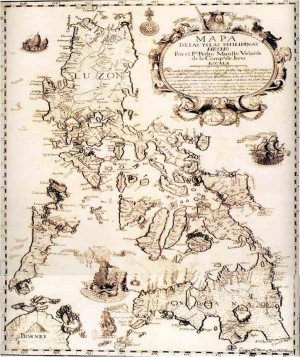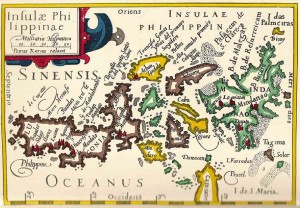
“Putting the Philippines on the Map,” an exhibit organized by the Philippine Map Collectors Society (Phimcos) to help promote a sense of national pride, is on view at the Mall of Asia main lobby until Sept. 1.
With texts in Filipino and English, the exhibit hopes to make the appreciation and interpretation of maps accessible to a wide audience.
Maps help us find our place in the world. They do not only point out where we are and where we want to go but they also tell us who we are. Maps instruct us about our history and identity. They provide us with a memory and a destiny. Maps give us a sense of self-esteem.
Our self-esteem grows as we see our country, gradually being put on the map—on Ramusio-Gastaldi’s 1554/1563 map, where the word “Filipina” appears for the first time on a western document; next on Abraham Ortelius’s 1584/1601 map of China, with only the coastline of Luzon; and finally on Petrus Kaerius’s 1598 “Insulae Philippinae,” [Map 1] the first separately printed map of the Philippines.
The ‘Icarian view’
To appreciate maps, it may help to look first at Pieter Bruegel’s 1558 painting “The Fall of Icarus.” Bruegel presents a panoramic view with three characters in the foreground—a farmer, a shepherd, and a fisherman—too absorbed in their tasks to even notice the tragic event nearby.

Icarus and his father, Daedalus, are imprisoned in the palace of Minos. Deciding to escape by air, Daedalus constructs flying machines of wax and feathers. He then orders his son to fly but not too near the sun. Icarus, out of pride, disobeys him. The wax of Icarus’s wings melts. Icarus plunges into the sea.
In “The Fall of Icarus,” one looks down from a high point and obtains an overall view of the world, with all its minute details. This sweeping view of the distant and of the detail is called the Icarian view. To look at a map is to view the world from above, to be like God who oversees everything. To oversee everything is to be everywhere, to experience the power of controlling everything and everyone. There is a compelling link between maps and power.
Why do antique maps fascinate us? Their appeal comes from the unique synthesis of geography, exploration, trade, travel, history, culture, science and art. Antique maps continue to charm us because they are prized works of beauty, documents of knowledge and coveted instruments of power.
A map is not only a physical object of beauty, knowledge and power. It is also a “metaphysical object” which makes us aware of a reality beyond the visible, prompting us to wonder about our unique being. Cartography thrives from a certain ambiguity. Situated at the intersection of exact science and art, the study of maps relies on physical description and mathematical theory. Still, it finds it necessary to reintroduce the imagination.
‘Cartographic transaction’
A map represents or, more aptly, presents the world. Maps render the world visible. But maps do not only reveal but also conceal. There are “silences” in maps. Maps display the world, as when they warn us where not to construct our homes. But they also can erase existing landmarks and differences. Here, one grasps what is truly unique to a map if one bears in mind the important “cartographic transaction”—the change of the physical world into a conceptual map. It should not surprise us then that maps are used to serve the ideology of conquest, the rhetoric of nationalism or the politics of cultural differences.
Three conceptual stages comprise this “cartographic transaction”: a first stage where space is measured; a second stage where space is visualized; and a third stage where space is narrated.
In the first stage of measurement, the “surveyor,” standing on the highest vantage point—a hilltop or a church tower—makes accurate calculations of the landscape. With the surveyor’s tools, the space of the world becomes quantifiable.
In the second stage of visualization, the map maker creates images that later circulate in society to lure people to a life of adventure, stir up their pride of place, or strengthen their religious fervor. The 1613 Gerard Mercator-Jodocus Hondius “Insulae Indiae Orientalis” map, [Map 2] which puts the Philippines at the very center of Asia, shows two ships—Spanish and Dutch—firing at each other. It proclaims Spain’s naval capacity, manifested in the sea battle off Manila Bay between Admiral Olivier Van Noort and Dr. Antonio de Morga in 1600. In the 1744 small version map of the Spanish Jesuit, Fr. Pedro Murillo Velarde [Map 3], we see St. Francis Xavier approaching Mindanao, bolstering the 18th-century fond belief that the “Apostle of the Indies” set foot there.
Narration of space
In the third stage of narration, space is recounted. There is a discourse of geography. Maps narrate a new social, economic, or political order. They forge an identity—both cultural and national. Here, local maps become important for the enhancement of self-esteem like the 1760 “Carta Hydrographica y Corographica de las Yslas Filipinas” of Fr. Pedro Murillo Velarde.
To appreciate the map as a graphic representation of space, one must see the link between maps and picture making. This link goes back to Ptolemy’s Geographia. The only Greek word available to Ptolemy in referring to a “maker of pictures” was graphiks. The common meaning of the suffix graph? is not only “to draw” but “to record and write.” During the Renaissance, graph is replaced by the Latin descriptio. This word calls attention to a mode of pictorial representation. As “description,” maps enable us to see what is beyond the visible. Maps then do not only provide us information on the shapes of coastlines and the distances between towns but enrich us with political, social, ethnological, linguistic and strategic knowledge.
To illustrate this, different narratives are told by the texts at the back of the 1598 Kaerius map and in the southwest medallion of the 1760 Murillo Velarde map. In the Kaerius map, the “description” states that there are “inhabitants without laws” who are “cannibals.” In the Murillo Velarde map drawn by Francisco Suarez and engraved by Nicolas de la Cruz Bagay, both Filipinos, we read: “…The Indios [Filipinos] are well-built, have fine features and are dusky in complexion. They become good writers, painters, sculptors, blacksmiths, goldsmiths, embroiderers and sailors.” Here, two different subjective attitudes are at work. The first one is disdainful; the second benevolent. The narration produces different spaces of meaning.
The interpretation of maps, especially antique ones, invites us to travel—to embark on a journey of the imagination and venture into the space of what is more truly “real.” This is the world of the creative word—of narratives, both literary and historical. Maps tell the story of space. To name a place is already to tell a story. There are as many stories as there are names on a map. Like a true lover, the map lover never tires of looking at maps, imagining and recounting stories in the pursuit of being human [Map 4].
E-mail the author at lgarcia@ateneo.edu.

